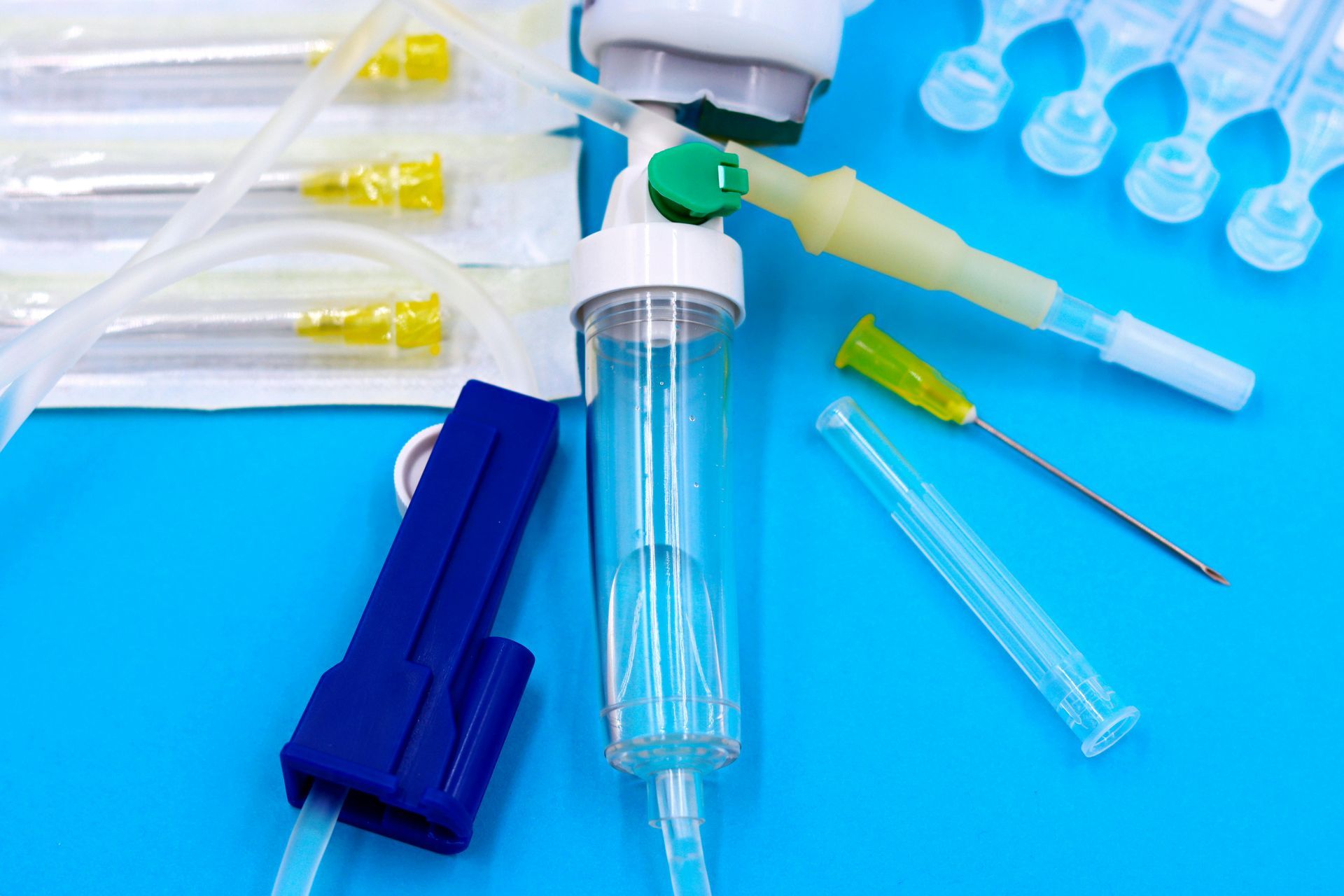Common IV Antibiotics Side Effects and How to Manage Them
IV antibiotics are powerful medications that treat serious infections quickly. They work by delivering medicine directly into your bloodstream.
While effective, intravenous antibiotics can sometimes cause side effects. These range from mild discomfort to rare but serious reactions. The good news is that most IV therapy side effects are manageable with the right care and guidance.
Common Side Effects of IV Antibiotics

Most people tolerate IV antibiotics well, but side effects are fairly common. Still, knowing what to expect helps you feel more prepared and allows you to act quickly if something seems unusual.
Local Reactions at the Injection Site
The most common side effects occur at the site of IV insertion. You may notice redness, swelling, tenderness, or mild pain near the needle site. A small bruise or lump sometimes forms if the vein becomes irritated.
In some cases, the vein can feel firm or warm, which may suggest mild inflammation. Rarely, blood clots can form near the IV catheter or PICC lines, especially with prolonged use. These symptoms usually improve within a few days or after the IV line is adjusted.
Applying a warm compress, raising the affected arm, or changing the IV catheter (infusion) site can help alleviate discomfort. Always tell your provider if pain worsens or spreads. Licensed infusion nurses usually monitor these reactions closely to keep patients comfortable.
Digestive Upset
Even though intravenous antibiotics bypass the stomach, they still affect your digestive system. Antibiotics don’t just target harmful bacteria; they also disrupt the “good” bacteria that support gut health. This imbalance often leads to uncomfortable side effects.
Common digestive issues include:
- Nausea: Feeling queasy during or after the infusion.
- Diarrhea: Loose or frequent stools caused by bacterial imbalance.
- Stomach cramps: Abdominal discomfort that may come and go.
- Vomiting: Less common, but possible if your gut bacteria are heavily disrupted.
- Loss of appetite: Reduced desire to eat while the body adjusts to treatment.
In most cases, these side effects are mild and resolve once treatment ends. However, persistent diarrhea, abdominal pain, or fever may indicate Clostridioides difficile infection, a germ that causes diarrhea and infectious colitis (an inflammation of the colon). A stool culture (test) may be done to confirm the cause.
Overuse or incomplete antibiotic courses also increase the risk of antibiotic resistance, where bacteria adapt and become harder to treat. This makes it important to always complete your antibiotic courses.
Ways to manage and reduce digestive upset include:
- Eating probiotic-rich foods like yogurt, kefir, or fermented vegetables can help restore healthy gut flora.
- Staying hydrated with water or electrolyte drinks to replace fluids lost through diarrhea.
- Eating small, bland meals such as rice, bananas, or toast can help reduce irritation.
- Avoiding spicy, greasy, or high-fat foods that can worsen stomach symptoms.
- Ask your provider about supplements like probiotics if you experience recurring gut issues.
By monitoring your symptoms and supporting your gut health, you can minimize discomfort and reduce the risk of more serious complications.
Allergic Reactions
Allergic reactions can range from mild to serious. Mild reactions often cause skin changes like itching, skin rashes, or small red bumps. These typically fade once treatment stops, but they should never be ignored.
People with a penicillin allergy are especially at risk of adverse drug reactions during antibiotic therapy. In rare cases, more serious reactions may develop, including swelling of the lips or face, wheezing, or difficulty breathing. If you experience these severe symptoms, it may be anaphylaxis, which requires immediate emergency care.
Always inform your provider if you have a history of drug allergies, including drug eruptions or reactions linked to a penicillin allergy.
Yeast Infections
Intravenous antibiotics can upset your body’s natural bacterial balance, especially in the gut and genital areas. This imbalance gives yeast, such as Candida, a chance to multiply unchecked. When yeast overgrows, infections may develop in the mouth, gut, or genital areas.
Women are particularly prone to vaginal yeast infections during antibiotic treatment. Symptoms may include:
- Persistent itching or irritation in the vaginal area
- Burning sensation during urination or intercourse
- Thick, white, odorless discharge resembling cottage cheese
- Swelling or redness around the vaginal opening
Oral thrush is another possible side effect, especially in people with weakened immune systems. Signs include white patches on the tongue, inner cheeks, or throat, along with soreness or difficulty swallowing.
Ways to manage and prevent yeast infections during intravenous antibiotic therapy include:
- Taking probiotics to help restore healthy gut and vaginal bacteria.
- Wearing breathable cotton underwear to reduce moisture and discourage yeast growth.
- Avoiding scented soaps or douches, which can disrupt the vaginal environment.
- Eating a balanced diet low in refined sugar, since yeast thrives on sugar.
- Use antifungal creams or oral medication if prescribed by your doctor.
If you’ve experienced vaginal yeast infections or other fungal infections, inform your provider before starting antibiotics. They may recommend preventive strategies, such as early use of probiotics or antifungal medication alongside your treatment.
Fatigue or Weakness
Many patients feel unusually tired while receiving IV antibiotics. This fatigue may come from several factors. The infection itself places stress on your immune system, while antibiotics can alter normal body functions and energy levels. Treatment sessions may also interrupt rest or add to overall stress.
Fatigue often appears as:
- Persistent tiredness even after resting
- Muscle weakness or heaviness in the limbs
- Difficulty focusing or staying alert
- Reduced stamina during daily activities
In most cases, this tiredness is temporary and improves once treatment ends. However, extreme fatigue may signal something more serious. It might be low blood counts, dehydration, or organ strain from liver disease or kidney disease.
You can manage mild fatigue with simple adjustments:
- Prioritize rest by allowing your body more sleep and recovery time.
- Stay hydrated since dehydration can worsen tiredness and muscle weakness.
- Eat nutrient-rich foods like lean proteins, fruits, and whole grains to support energy levels.
- Engage in light activity, such as short walks, to improve circulation without exhausting yourself.
- Communicate with your provider if fatigue is severe, sudden, or persistent.
While some weakness is normal during treatment, always monitor your energy and report unusual symptoms.
Severe but Less Common Side Effects
Although uncommon, some side effects of IV antibiotics can be serious and require immediate medical attention.
One possible reaction is severe allergy, also known as anaphylaxis. This is more likely if you have a penicillin allergy. Symptoms include sudden swelling of the face or throat, difficulty breathing, chest tightness, or dizziness. These symptoms appear quickly and must be treated as a medical emergency.
Long-term or high-dose IV antibiotics can sometimes place stress on the kidneys or liver. Signs of organ strain may include unusual changes in urine color, abdominal discomfort, swelling in the legs, or yellowing of the skin and eyes. Blood tests are often used during extended treatment to monitor organ function and catch problems early.
Another risk is infection with Clostridioides difficile (C. diff). This can arise after viral infections or bacterial infections disrupt gut balance. Symptoms include persistent diarrhea, abdominal pain, fever, and dehydration. Severe cases require hospitalization and additional treatment to restore balance.
These serious side effects are rare, but they highlight the importance of medical supervision during IV antibiotic therapy. Always report unusual or worsening symptoms to your healthcare provider immediately.
How to Manage IV Antibiotics Side Effects Safely
Most side effects from IV antibiotics are mild and can be managed with the right care. A few practical steps at home, combined with good communication and preventive measures, can make treatment more comfortable and safer.
You can manage side effects by:
- Staying hydrated: Drink water or electrolyte drinks to replace lost fluids and reduce fatigue.
- Eating probiotic-rich foods: Yogurt, kefir, or fermented vegetables help restore gut balance.
- Rest often: Allow your body time to recover while fighting infection and adjusting to treatment.
- Using warm compresses: Apply to the IV line site to ease pain, swelling, or irritation.
- Reporting symptoms early: Tell your provider about persistent nausea, diarrhea, or unusual reactions.
- Following dosing instructions: Take the full antibiotic course as prescribed, even if you stop feeling sick.
- Avoiding alcohol: Alcohol worsens side effects and can increase the risk of drug interaction.
- Asking about supplements: Only take probiotics or vitamins if your doctor recommends them.
These strategies lower the chance of complications. Most importantly, stay in close contact with your provider or home health nurse during treatment. Many patients benefit from home intravenous antibiotic therapy, which allows infusion nurses to deliver care safely in a familiar environment.
When to Seek Medical Attention
Some side effects need urgent care. Contact your provider if you experience:
- High fever or chills: These may indicate the infection is not improving or a new one has developed.
- Severe rash or swelling: Could be a drug eruption or severe allergic reaction that needs fast treatment before it worsens.
- Difficulty breathing: A possible sign of a penicillin allergy or anaphylaxis, which is life-threatening.
- Persistent diarrhea or bloody stool: May point to Clostridioides difficile infection or severe gut irritation.
- Sudden fatigue, confusion, or yellowing skin: Could signal kidney disease or liver strain, requiring urgent monitoring.
These symptoms should never be ignored. Always call your doctor or seek immediate medical attention if you are unsure about any new or worsening reaction.
For safe, supervised IV care at home, many patients choose Revive Mobile IV, where licensed professionals deliver treatment with comfort and oversight, helping you stay safe while you recover.










